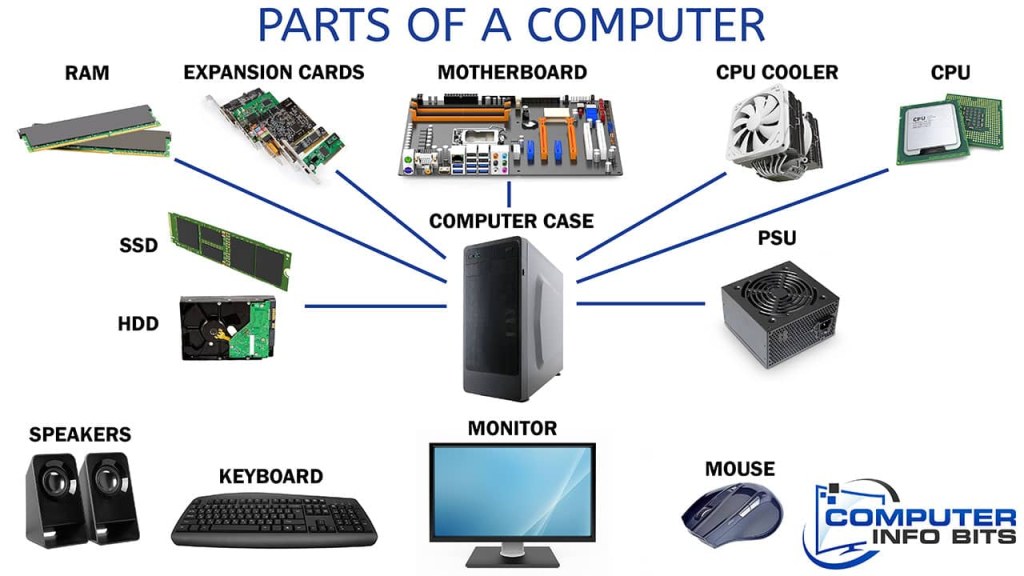The Ultimate Guide To Computer 5 Components: Unveiling The Secrets Of Building Your Own PC!
Computer 5 Components: Understanding the Building Blocks of Modern Technology
Introduction
Hello Readers,
2 Picture Gallery: The Ultimate Guide To Computer 5 Components: Unveiling The Secrets Of Building Your Own PC!


Welcome to an informative journey into the world of computers! In this article, we will explore the five essential components that make up these incredible machines. Whether you are a tech enthusiast, a student, or simply curious about the inner workings of computers, this article will provide you with valuable insights. So, let’s dive right in and uncover the mysteries of computer 5 components!
1. What Are Computer 5 Components?

Image Source: educba.com
🔎 To truly comprehend the essence of computers, it is crucial to understand the five fundamental components that bring them to life. These components include:
Central Processing Unit (CPU) 🖥️
Memory (RAM) 🧠
Storage Devices 💾
Motherboard 📀
Input and Output Devices ⌨️🖱️🖨️
Each component plays a unique role in enabling computers to perform complex tasks and fulfill our digital needs. Let’s explore each component in detail.
1.1 Central Processing Unit (CPU)
The CPU serves as the brain of the computer. It carries out instructions, performs calculations, and manages the flow of data. Without a CPU, computers would be incapable of executing any tasks.
1.2 Memory (RAM)

Image Source: computerinfobits.com
RAM, or Random Access Memory, is responsible for temporarily storing data that the CPU requires for immediate access. It enables faster processing speeds and allows computers to multitask efficiently.
1.3 Storage Devices
Storage devices, such as hard disk drives (HDDs) and solid-state drives (SSDs), provide long-term storage for data, programs, and operating systems. They retain information even when the computer is powered off.
1.4 Motherboard
The motherboard acts as a communication hub, connecting all the different components of a computer. It houses the CPU, RAM, and other essential hardware, allowing them to work together seamlessly.
1.5 Input and Output Devices
Input devices, such as keyboards and mice, allow users to interact with computers by providing input. Output devices, such as monitors and printers, display or produce the results of computer operations.
2. Who Invented Computer 5 Components?
🤔 The development of computer components can be attributed to countless engineers, scientists, and inventors. Charles Babbage, often referred to as the Father of the Computer, laid the groundwork for modern computing with his invention of the Analytical Engine in the mid-19th century.
Over the years, numerous contributions from innovators like John von Neumann, Alan Turing, and Gordon Moore have shaped the evolution of computer components. Their groundbreaking work has paved the way for the advanced technology we rely on today.
3. When Were Computer 5 Components First Utilized?
⌛ Computer 5 components have evolved over time, with each component’s inception occurring at different periods. The CPU, as we know it today, can be traced back to the 1960s, while the concept of memory dates back even further to the 1940s.
Storage devices have undergone significant advancements since the first commercial hard drive was introduced in 1956. Similarly, input and output devices have evolved from early punch cards and teletypewriters to the sleek keyboards and touchscreens we use today.
4. Where Are Computer 5 Components Utilized?
🌍 Computer 5 components are utilized worldwide in various industries and sectors. From personal computers in households to massive server farms powering cloud services, these components are the building blocks of modern technology.
They are indispensable in fields such as business, education, healthcare, entertainment, and scientific research. Whether it’s analyzing complex data, creating stunning visual effects, or simply staying connected with loved ones, computer components are at the core of our digital lives.
5. Why Are Computer 5 Components Important?
🔑 Computer 5 components are essential because they enable computers to perform a wide range of tasks efficiently and effectively. The CPU’s processing power, combined with memory and storage capacities, allows computers to execute complex calculations, store vast amounts of data, and run sophisticated software.
Furthermore, the interconnectedness of these components through the motherboard ensures seamless communication and data transfer. Without these components, the technology landscape as we know it would cease to exist.
6. How Do Computer 5 Components Work Together?
🔧 The synergy among computer 5 components is what makes them a powerful and cohesive unit. The CPU retrieves instructions from memory, performs calculations, and stores temporary results back into memory. It also interacts with storage devices to load and save data.
Meanwhile, the motherboard acts as a conduit, facilitating data exchange between different components. Input devices allow users to provide commands and data, while output devices display the results or produce tangible outputs.
Advantages and Disadvantages of Computer 5 Components
Advantages
1. Speed and Efficiency: Computer 5 components enable fast processing speeds and multitasking capabilities, increasing productivity.
2. Storage Capacity: Storage devices offer ample space to store vast amounts of data, making it easily accessible.
3. Versatility: Input and output devices allow users to interact with computers in various ways, catering to different needs.
4. Scalability: Computer components are scalable, allowing users to upgrade or expand their systems as needed.
5. Connectivity: The interconnectedness of components ensures smooth data transfer, facilitating seamless communication.
Disadvantages
1. Cost: High-performance computer components can be expensive, limiting accessibility for some users.
2. Compatibility Issues: Certain hardware or software may not be compatible with specific components, leading to compatibility challenges.
3. Complexity: Understanding the intricate workings of computer components can be challenging for non-technical users.
4. Vulnerability to Failure: Component failures, such as hard drive crashes, can result in data loss or system malfunctions.
5. Power Consumption: Powerful components require more energy, contributing to higher electricity consumption.
Frequently Asked Questions (FAQs)
1. Are computer components interchangeable?
Yes, certain computer components, such as RAM and storage devices, are often interchangeable and can be upgraded or replaced to meet specific requirements.
2. Can I build my own computer?
Absolutely! Building your own computer allows you to customize the components based on your needs and preferences. However, it requires some technical knowledge and research.
3. How often should I upgrade my computer components?
The frequency of component upgrades depends on factors such as your usage requirements, budget, and the pace of technological advancements. Generally, upgrading every 3-5 years is recommended.
4. Can computer components be recycled?
Yes, computer components can be recycled through electronic waste recycling programs. It is crucial to dispose of them responsibly to minimize environmental impact.
5. Are there any risks involved in upgrading computer components?
While upgrading computer components can enhance performance, there is a risk of incompatibility or damage if not done correctly. It’s advisable to seek professional assistance or thoroughly research the process beforehand.
Conclusion: Empowering Your Digital Experience
In conclusion, understanding the intricate workings of computer 5 components allows us to appreciate the technological marvels that surround us. From the powerful CPU to the versatile input and output devices, each component plays a vital role in shaping our digital experience.
Whether you are a computer enthusiast, a professional, or an everyday user, knowledge about these components empowers you to make informed choices when it comes to purchasing, upgrading, or troubleshooting your computer.
So, embrace the digital world with confidence and unlock the unlimited possibilities that computer 5 components can offer!
Final Remarks
📝 In this article, we have explored the fascinating world of computer 5 components and their significance in our lives. The incredible advancements in technology owe a great deal to these components and the brilliant minds behind their invention.
As technology continues to evolve, it is imperative to stay updated and adapt to the ever-changing digital landscape. Whether you are a professional, a student, or simply someone who appreciates the power of computers, understanding the components that drive these machines is essential.
Remember, computer 5 components are the building blocks of innovation and progress. So, embrace the possibilities they offer and embark on a journey of endless discovery in the world of computers!
This post topic: Electronics
